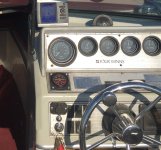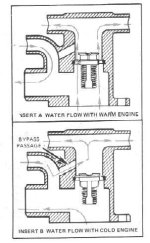I've got a 2009 Glastron GT205 with Volvo Penta 5.0 GL-J and SX-A drive. I bought it late in the 2020 season and it has less than 250 hours on it. In the past, I've never seen the temperature gauge move very much from 150 degrees, once it was warmed up, at idle or on plane. I took it out for the first time this season, and a quarter mile from the dock, it was approaching 200 degrees. I brought it back to idle, and it slowly dropped to a little over 175. I'd appreciate any guidance on how to diagnose this. Here is what I've done and observed so far:
- ran off the garden hose into the engine water port (no muffs). Temperature went up to ~175 again (idle or fast idle up to ~1200 rpm). This seems to suggest the problem is not due to sucking air at the drive since I bypassed the drive.
- checked raw water impeller, and it looks fine to me (no cracks or tears; fits tight in the housing). I installed it a year ago and I have about 50 hours on it. Owners manual recommends changing at this age. Maybe I should.
- checked engine oil (which was changed in fall when I winterized). Looks fine. No indication of water.
- replaced thermostat with VP 3587597. Still goes up to ~175 on the garden hose. Maybe higher -- I didn't want to push it. So, it doesn't seem to be the thermostat.
- Exhaust manifolds are easy to touch -- seem to be cooling fine.
- top of thermostat housing (above the thermostat, where raw water enters) is cold. Bottom of housing (engine circulation) is uncomfortably warm to touch.
Next, I plan to check the temperature sender (I believe this is VP item 3852029). I can't find any information on how resistance should vary with temperature. Does anyone have a calibration or know where to look? I am kind of doubtful that this is the problem though. Since temperature went much higher under load, this seems like more of a water flow problem, but I'm a novice at this.
Also, my buddy will bring his IR thermometer gun tomorrow to check surface temperatures.
Any suggestions on where to look next? This is really baffling me.
Thanks for your help!
- ran off the garden hose into the engine water port (no muffs). Temperature went up to ~175 again (idle or fast idle up to ~1200 rpm). This seems to suggest the problem is not due to sucking air at the drive since I bypassed the drive.
- checked raw water impeller, and it looks fine to me (no cracks or tears; fits tight in the housing). I installed it a year ago and I have about 50 hours on it. Owners manual recommends changing at this age. Maybe I should.
- checked engine oil (which was changed in fall when I winterized). Looks fine. No indication of water.
- replaced thermostat with VP 3587597. Still goes up to ~175 on the garden hose. Maybe higher -- I didn't want to push it. So, it doesn't seem to be the thermostat.
- Exhaust manifolds are easy to touch -- seem to be cooling fine.
- top of thermostat housing (above the thermostat, where raw water enters) is cold. Bottom of housing (engine circulation) is uncomfortably warm to touch.
Next, I plan to check the temperature sender (I believe this is VP item 3852029). I can't find any information on how resistance should vary with temperature. Does anyone have a calibration or know where to look? I am kind of doubtful that this is the problem though. Since temperature went much higher under load, this seems like more of a water flow problem, but I'm a novice at this.
Also, my buddy will bring his IR thermometer gun tomorrow to check surface temperatures.
Any suggestions on where to look next? This is really baffling me.
Thanks for your help!
























